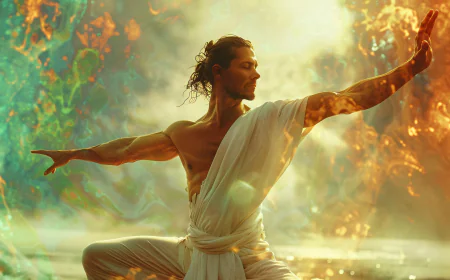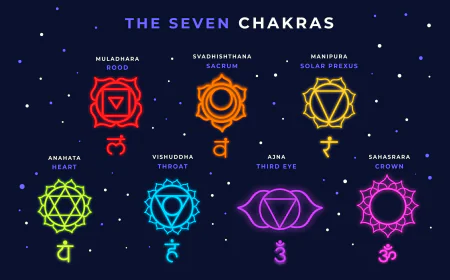Kundalini Shakti: The Coiled Serpent of Spiritual Awakening
Kundalini Shakti, often visualized as a coiled serpent ,represents the primal cosmic energy lying dormant within every individual Kundalini awakening offers super consciousness.

Kundalini Shakti: The Coiled Serpent of Spiritual Awakening
The concept of Kundalini Shakti, often visualized as a coiled serpent at the base of the spine, has fascinated spiritual seekers, yogis, and scholars for millennia. Rooted in ancient Tantric and yogic traditions, Kundalini represents the primal cosmic energy lying dormant within every individual. Its awakening is described as the ultimate key to self-realization, bridging the human and the divine. This article explores the symbolism, mechanics, practices, and profound challenges of Kundalini awakening, offering a comprehensive guide for those drawn to this transformative path.

"Kundalini Shakti: The Coiled Serpent of Spiritual Awakening" explores the ancient yogic concept of Kundalini energy—a dormant cosmic force symbolized as a coiled serpent at the spine's base. The article unpacks its symbolism, the subtle body's anatomy (Suṣumnā, Ida, Pingala channels, chakras), and methods like yoga, meditation, and Tantra to awaken this energy. It addresses the physical, emotional, and psychological challenges of Kundalini awakening, including the "dark night of the soul," while offering grounding practices and integration strategies. Bridging ancient wisdom with modern neuroscience, the piece highlights Kundalini’s role in self-realization and liberation (moksha), appealing to spiritual seekers, yogis, and those curious about transcending egoic boundaries to unlock human potential.

Are you ready to awaken your true potential with kundalini awakening?
I. Understanding Kundalini: The Serpent Power
1. Symbolism of the Serpent Energy
The serpent is a universal archetype, appearing in mythologies worldwide as a symbol of wisdom, regeneration, and hidden power. In Kundalini philosophy, the serpent embodies dormant spiritual potential. Coiled three-and-a-half times at the Muladhara Chakra (root chakra), it represents:
-
Potential Energy: Like a compressed spring, Kundalini holds immense power waiting to be unleashed.
-
Transcendence: The serpent’s upward movement mirrors the soul’s journey from earthly consciousness (materialism) to cosmic awareness (enlightenment).
-
Duality and Unity: The serpent’s dual nature—earthbound yet divine—reflects the human condition, straddling the physical and spiritual realms.

In Hindu iconography, deities like Shiva and Vishnu are often depicted with serpents, symbolizing mastery over primal forces. Similarly, the caduceus (a staff entwined with two serpents) in Greek mythology echoes the balance of opposing energies central to Kundalini’s ascent.
2. Kundalini in the Subtle Body: The Suṣumnā Nāḍī and Beyond
The yogic subtle body comprises 72,000 nāḍīs (energy channels), with three primary pathways:
-
Suṣumnā Nāḍī: The central channel running along the spine, from Muladhara to Sahasrara (crown chakra). It is the highway for Kundalini’s ascent.
-
Ida and Pingala Nāḍīs: These flank Suṣumnā, representing lunar (Ida) and solar (Pingala) energies. Their intersection at the Ajna Chakra (third eye) signifies the merging of duality into unity.
Kundalini’s journey through Suṣumnā involves piercing granthis (psychic knots)—Brahma (root), Vishnu (heart), and Rudra (third eye)—each tied to attachments like fear, desire, and illusion. The awakening process dissolves these knots, liberating the practitioner from limiting patterns.
The Chakra System: Kundalini’s ascent activates the seven primary chakras, each governing specific aspects of consciousness:
-
Muladhara (Root): Survival, grounding.
-
Svadhishthana (Sacral): Creativity, sexuality.
-
Manipura (Solar Plexus): Willpower, identity.
-
Anahata (Heart): Love, compassion.
-
Vishuddha (Throat): Communication, truth.
-
Ajna (Third Eye): Intuition, insight.
-
Sahasrara (Crown): Unity, transcendence.

Each chakra’s activation purifies related psychological and physical blockages, culminating in the union of Shakti (Kundalini) and Shiva (pure consciousness) at Sahasrara.
II. Kundalini Awakening: Pathways and Practices
Kundalini awakening is a deeply personal and transformative journey, and the methods to achieve it are as diverse as the individuals who undertake it. Rooted in ancient yogic and Tantric traditions, these practices aim to awaken the dormant Kundalini energy and guide it through the subtle body, leading to self-realization and spiritual liberation. Below, we explore the traditional methods of awakening, the role of the Guru, and the importance of sacred initiation.
1. Methods of Awakening: Yoga, Meditation, and Tantra
Kundalini awakening is not a one-size-fits-all process. It requires a combination of physical, mental, and spiritual practices tailored to the practitioner’s readiness and temperament. Here are the primary traditional methods:
A. Hatha Yoga: Preparing the Body and Mind
Hatha Yoga is often the foundation for Kundalini awakening. It prepares the body and mind through a combination of postures (āsanas), breath control (prāṇāyāma), and energy locks (bandhas). Key practices include:
-
Mula Bandha (Root Lock): This practice involves contracting the perineum or cervix to direct energy upward, preventing its dissipation and encouraging its movement through the central channel (Suṣumnā Nāḍī).
-
Bhastrika Pranayama (Bellows Breath): A powerful breathing technique that generates internal heat, stimulating the Kundalini energy and clearing blockages in the energy channels.
-
Āsanas (Postures): Specific postures, such as the Cobra Pose (Bhujangasana) or Lotus Pose (Padmasana), help open the chakras and prepare the spine for the upward flow of energy.

B. Kundalini Yoga: Activating the Energy
Kundalini Yoga is a dynamic and intensive practice designed to rapidly awaken and channel Kundalini energy. It combines postures, breathwork, mantra chanting, and meditation. Key practices include:
-
Sat Kriya: A repetitive spinal flexing exercise that generates energy and helps “shake loose” stagnant energy in the spine.
-
Breath of Fire (Kapalabhati): A rapid, rhythmic breathing technique that purifies the nervous system and increases vitality.
-
Mantra and Mudra: The use of sacred sounds (e.g., “Sat Nam”) and hand gestures (mudras) to focus the mind and direct energy.

C. Meditation: Cultivating Inner Awareness
Meditation is a cornerstone of Kundalini awakening, helping to calm the mind, focus awareness, and facilitate the movement of energy. Key practices include:
-
Trataka (Candle Gazing): A concentration practice that involves staring at a candle flame to stimulate the Ajna Chakra (third eye) and enhance intuition.
-
Nada Yoga (Sound Meditation): The use of sound vibrations, such as chanting “OM” or listening to inner sounds (e.g., flutes or bells), to resonate with and activate the chakras.
-
Mindfulness and Vipassana: Observing the breath and bodily sensations to cultivate present-moment awareness and dissolve mental blockages.

D. Tantric Practices: Harnessing Energy for Transformation
Tantra views the body as a sacred temple and uses rituals, visualization, and sensory experiences to transcend the ego and awaken Kundalini. Key practices include:
-
Mantra Siddhi: The repetition of bija (seed) mantras, such as “LAM” for Muladhara or “OM” for Sahasrara, to awaken and balance the chakras.
-
Yantra Visualization: Focusing on geometric symbols (yantras) to concentrate the mind and channel energy.
-
Sacred Sexuality: Using the energy of desire and intimacy as a tool for spiritual transformation, often in the context of a committed partnership.

E. Spontaneous Awakening: The Role of Life Events
In rare cases, Kundalini awakening occurs spontaneously, triggered by life events such as:
-
Trauma or near-death experiences.
-
Intense devotion or spiritual practices.
-
Profound emotional or psychological shifts.
These awakenings can be overwhelming without proper guidance, highlighting the importance of support and integration.
2. The Role of the Guru and Sacred Initiation
In traditional Kundalini practices, the Guru (spiritual teacher) plays a central and indispensable role. The Guru is seen as a guide, protector, and conduit for divine grace. Here’s how the Guru supports the awakening process:

A. Transmitting Shaktipat: The Divine Initiation
Shaktipat is the grace-bestowing initiation where the Guru awakens the disciple’s Kundalini through touch, gaze, or intention. This transmission is considered a profound act of spiritual empowerment, aligning the disciple with the Guru’s energy and wisdom.
B. Providing Guidance and Safeguards
Kundalini’s unpredictable energy can be overwhelming, leading to physical, emotional, and psychological challenges. The Guru offers:
-
Techniques (kriyas) to manage and direct the energy.
-
Safeguards to prevent imbalance or harm.
-
Wisdom to navigate the spiritual journey with clarity and confidence.
C. Breaking Illusions and Egoic Patterns
The Guru’s role extends beyond technical guidance. Through tests, challenges, and mirroring, the Guru helps the disciple confront and dissolve unresolved shadows, attachments, and egoic patterns. This process is essential for true spiritual growth.
D. The Importance of a Qualified Guru
In the modern era, many seekers attempt self-awakening through books, online resources, or unqualified teachers. While these resources can be helpful, they often lack the depth and nuance of traditional Guru-disciple relationships. A qualified Guru ensures that the awakening process aligns with the student’s readiness, providing personalized guidance and support.
III. The Kundalini Experience: Symptoms, Challenges, and Integration
1. Physical and Emotional Symptoms of Kundalini Awakening
Kundalini awakening is a deeply transformative process that can manifest in a wide range of physical and emotional symptoms. These experiences vary widely from person to person, but they often follow a pattern of energy movement, purification, and integration. Below is a detailed account of the physical and emotional symptoms, based on personal experience and common reports from others who have undergone this process.
I. Physical Sensations
The physical sensations of Kundalini awakening can be intense, surprising, and sometimes overwhelming. They often reflect the movement of energy through the body, particularly along the spine and through the chakras. Here are some of the most common physical symptoms:
-
Heat and Energy Movement:
One of the earliest and most pronounced sensations is intense heat, often localized in specific areas of the body. This heat can feel like a burning or fiery energy moving up the spine. In my case, the heat was so extreme that I feared spontaneous combustion. This sensation typically occurs as the Kundalini energy encounters blockages or resistance in the energy channels (nāḍīs) and works to clear them. -
Energy Pulses and Vibrations:
As the energy moves through the body, it can create pulsating or vibrating sensations, particularly in the chakras. These pulses may feel like a rhythmic throbbing or a gentle, flowing current. Over time, these sensations can become more refined and subtle, often accompanied by feelings of bliss or expansion. -
Involuntary Movements (Kriyas):
The body may spontaneously shake, tremble, or move in ways that feel beyond conscious control. These movements, known as kriyas, are thought to be the body’s way of releasing stored tension and facilitating the flow of energy. For example, focusing attention on a specific area of the body can trigger shaking or trembling in that region. -
Pressure or Weight at the Crown:
A common sensation during Kundalini awakening is the feeling of pressure or weight at the top of the head, as if something alive and dynamic is resting there. This sensation often accompanies the opening of the Sahasrara (crown chakra) and can persist for extended periods. -
Silvery or Blissful Energy:
As blockages are cleared, the intense heat often gives way to more pleasurable sensations. These can feel like a silvery, luminous energy flowing through the body, bringing a sense of deep relaxation, joy, and connection to the divine. -
Heightened Sensitivity:
Kundalini awakening can lead to increased sensitivity in the physical senses. Sounds, lights, and tactile sensations may feel more intense or vivid. This heightened sensitivity can be both exhilarating and challenging, requiring periods of rest and grounding.

II. Emotional Symptoms
The emotional symptoms of Kundalini awakening are often intertwined with the physical sensations. As the energy moves through the body, it can trigger the release of stored emotional trauma, leading to a rollercoaster of feelings. Here are some common emotional experiences:
-
Euphoria and Bliss:
As the energy rises and clears blockages, it can produce profound feelings of joy, ecstasy, and unity with the universe. These moments of bliss are often described as transcendent and life-changing. -
Emotional Turbulence:
The release of stored emotions can lead to periods of intense emotional upheaval. This may include sudden outbursts of anger, sadness, or fear, as well as the resurfacing of past traumas. These episodes are often referred to as the “Dark Night of the Soul,” a phase of deep inner purification. -
Mood Swings:
The awakening process can cause rapid shifts between emotional states, from euphoria to despair and back again. These mood swings are a natural part of the process as the psyche integrates higher levels of awareness. -
Heightened Empathy:
As the heart chakra opens, many people experience a profound increase in empathy and compassion. This can be both beautiful and overwhelming, as the boundaries between self and others may feel less distinct. -
Existential Questions:
Kundalini awakening often brings a deep questioning of life’s meaning and purpose. This can lead to periods of introspection and a desire to align one’s life with higher spiritual values.
III. Integration and Long-Term Effects
Over time, the intense physical and emotional symptoms of Kundalini awakening tend to stabilize, giving way to a more balanced and integrated state of being. However, subtle sensations and shifts may continue for years or even decades. Here are some long-term effects:
-
Subtle Energy Awareness:
Even after the initial awakening, many people remain acutely aware of energy movements in their bodies. This can include gentle pulsations, warmth, or a sense of expansion in the chakras. -
Ongoing Purification:
The process of purification may continue as the energy works through deeper layers of conditioning and trauma. This can manifest as occasional physical discomfort or emotional release. -
Blissful States:
As the energy stabilizes, feelings of bliss and connection to the divine may become a more constant presence in daily life. These states are often accompanied by a deep sense of peace and fulfillment. -
Service and Purpose:
Many people feel called to share their experiences and insights with others, often through healing, teaching, or creative work. This sense of purpose is a natural outgrowth of the awakening process.

Navigating the Symptoms
The physical and emotional symptoms of Kundalini awakening can be challenging to navigate, especially in the early stages. Here are some tips for managing the process:
-
Grounding Practices:
Walking barefoot, spending time in nature, and eating grounding foods (like root vegetables) can help stabilize the energy. -
Seeking Support:
Connecting with a knowledgeable teacher, therapist, or community can provide reassurance and guidance during difficult phases. -
Self-Care:
Prioritizing rest, hydration, and a balanced lifestyle can help the body and mind integrate the changes. -
Patience and Trust:
Trusting the process and allowing it to unfold at its own pace is key. Kundalini awakening is a journey, not a destination.
2. Navigating Psychological Turbulence
To avoid overwhelm, practitioners are advised to:
-
Ground: Walk barefoot, eat root vegetables, practice mindfulness.
-
Purify: Follow a sattvic (pure) diet, avoid stimulants, and cultivate ethical living (yama/niyama).
-
Seek Support: Therapists familiar with spiritual crises, or sangha (community), provide stability.
Integration: Post-awakening, individuals often feel called to serve others, channeling their expanded awareness into creative or healing work.
IV. Kundalini in the 21st Century
Kundalini has gained widespread popularity in contemporary wellness and spiritual circles, but its modern interpretation often diverges from its traditional roots. Here’s an exploration of its current relevance:
-
Wellness and Healing:
Many practitioners today turn to Kundalini practices for their transformative potential in addressing mental, emotional, and physical health issues. Reports of healing from addiction, depression, anxiety, and chronic illnesses are common among those who engage deeply with Kundalini Yoga and meditation. These practices are seen as tools for self-empowerment and holistic well-being. -
Commodification and Commercialization:
The rise of Kundalini’s popularity has led to its commodification in some circles. For example, phrases like “Kundalini Yoga for weight loss” or “quick Kundalini awakening” are marketed to appeal to mainstream audiences. Critics argue that this dilutes the sacred purpose of Kundalini, reducing it to a fitness trend or self-help tool rather than a profound spiritual path. -
Cultural Appropriation:
Kundalini’s integration into Western wellness culture has also raised concerns about cultural appropriation. Traditional practices are often stripped of their cultural and spiritual context, leading to a superficial understanding of their depth and significance. This has sparked debates about the ethical responsibility of modern practitioners and teachers to honor Kundalini’s origins. -
Genuine Seekers and Authentic Practices:
Despite these challenges, many individuals are drawn to Kundalini for its authentic spiritual potential. For these seekers, Kundalini remains a path to self-realization, inner peace, and connection to the divine. The growing availability of qualified teachers and resources has made it easier for serious practitioners to engage with Kundalini in a meaningful way.

2. Neuroscience and Kundalini
Modern science has begun to explore the physiological and neurological effects of Kundalini practices, offering insights into how these ancient techniques impact the brain and body. Here are some key findings:
-
Increased Gamma Brain Waves:
Studies on advanced meditators, including those practicing Kundalini techniques, have shown elevated levels of gamma brain waves. These high-frequency waves are associated with heightened awareness, peak concentration, and states of bliss. Gamma activity is often linked to the integration of sensory and cognitive processes, suggesting that Kundalini practices may enhance overall brain function. -
Suppression of the Default Mode Network (DMN):
The Default Mode Network (DMN) is a network of brain regions active during self-referential thinking, such as rumination or daydreaming. Research indicates that Kundalini meditation can suppress DMN activity, leading to reduced egoic thinking and a sense of unity with the universe. This suppression is often associated with feelings of transcendence and oneness. -
Neuroplasticity and Brain Rewiring:
Sustained Kundalini practices have been shown to promote neuroplasticity—the brain’s ability to reorganize itself by forming new neural connections. This rewiring can lead to increased resilience, emotional regulation, and compassion. Over time, practitioners may experience lasting changes in their thought patterns, behaviors, and emotional responses. -
Comparisons to Psychedelic Experiences:
Researchers have drawn parallels between Kundalini experiences and the effects of psychedelics, such as psilocybin or LSD. Both Kundalini awakening and psychedelic journeys are known to dissolve ego boundaries, alter perception of time and space, and induce mystical or non-ordinary states of consciousness. These similarities have sparked interest in using Kundalini practices as a natural, non-pharmacological means of achieving similar states. -
Stress Reduction and Emotional Healing:
Kundalini practices, particularly breathwork (prāṇāyāma) and meditation, have been shown to reduce stress and promote emotional healing. By activating the parasympathetic nervous system, these practices help regulate the body’s stress response, leading to improved mental and physical health.
3. Bridging Ancient Wisdom and Modern Science
The intersection of Kundalini’s ancient wisdom and modern scientific inquiry offers a unique opportunity to validate and deepen our understanding of this transformative practice. By combining traditional knowledge with empirical research, we can:
-
Validate Spiritual Experiences:
Scientific studies provide a framework for understanding the physiological and psychological effects of Kundalini, helping to legitimize spiritual experiences that were once dismissed as purely mystical or subjective. -
Enhance Practice and Teaching:
Insights from neuroscience can inform the development of more effective Kundalini practices and teaching methods, ensuring they are accessible and beneficial for a wider audience. -
Promote Holistic Well-Being:
By integrating Kundalini practices into modern healthcare and wellness programs, we can address the growing need for holistic approaches to mental and physical health.
V. Conclusion: The Serpent’s Gift
Kundalini Shakti is far more than an esoteric concept or ancient myth—it is a living, breathing force that pulses within every individual, waiting to be awakened. For millennia, this primal energy has been revered as the key to self-realization, the bridge between the human and the divine, and the ultimate path to liberation (moksha). Its awakening is not merely a spiritual event but a profound transformation of body, mind, and soul, demanding courage, discipline, and unwavering humility. Yet, for those who embark on this journey, the rewards are immeasurable: a state of bliss (ananda), a deep sense of unity with the cosmos, and the realization of one’s true nature.
The coiled serpent at the base of the spine is a powerful symbol of humanity’s dormant potential. Like a seed buried in the earth, Kundalini holds the promise of growth, renewal, and transcendence. Its upward journey through the chakras mirrors the soul’s ascent from the confines of earthly consciousness to the boundless realms of cosmic awareness. Each step of this journey—whether through the fiery heat of purification, the ecstatic visions of light, or the profound stillness of unity—brings us closer to the divine essence within.
Yet, Kundalini is not a path for the faint of heart. It challenges us to confront our deepest fears, dissolve our most entrenched attachments, and surrender to the unknown. It demands that we face the shadows within ourselves, embrace the full spectrum of our humanity, and rise above the illusions of the ego. In doing so, it offers us the ultimate gift: the realization that we are not separate from the universe but an integral part of its infinite tapestry.
As the ancient text Shiva Samhita declares:
“When the sleeping Kundalini awakens by favor of a Guru, then all the lotuses (chakras) and knots are pierced through. Then the Prana enters the Suṣumnā, and the mind becomes free.”
These words remind us that Kundalini awakening is not merely a personal achievement but a sacred process guided by grace. It is a journey that transcends the individual, connecting us to the timeless wisdom of the ages and the collective consciousness of humanity.
In a world that often feels fragmented and disconnected, Kundalini remains a beacon of hope and transformation. It calls us to remember our divine nature, to awaken to our highest potential, and to live in harmony with the universe. Whether approached through the disciplined practices of yoga, the devotional path of bhakti, or the mystical rituals of Tantra, Kundalini invites us to uncoil the serpent within, rise to our fullest expression, and merge with the infinite.
The serpent’s gift is not just for the few but for all who seek truth, freedom, and unity. It is a reminder that divinity resides within each of us, waiting to be awakened. As we heed this call, we step into our role as co-creators of a more conscious, compassionate, and awakened world.
TABLE OF CONTENT:
| Section | Topics | Sub-Topics |
|---|---|---|
| Introduction | Kundalini Shakti: The Coiled Serpent | - Overview of Kundalini - Purpose of the Article |
| I. Understanding Kundalini | 1. Symbolism of the Serpent Energy | - Potential Energy - Transcendence - Duality and Unity |
| 2. Kundalini in the Subtle Body | - Suṣumnā Nāḍī - Ida and Pingala Nāḍīs - The Chakra System |
|
| II. Kundalini Awakening | 1. Methods of Awakening | - Hatha Yoga - Kundalini Yoga - Meditation - Tantric Practices - Spontaneous Awakening |
| 2. The Role of the Guru | - Transmitting Shaktipat - Providing Guidance - Breaking Illusions |
|
| III. The Kundalini Experience | 1. Physical and Emotional Symptoms | - Physical Sensations - Emotional Symptoms - Integration and Long-Term Effects |
| 2. Navigating Psychological Turbulence | - Grounding Practices - Seeking Support - Self-Care - Patience and Trust |
|
| IV. Kundalini in the 21st Century | 1. Modern Relevance | - Wellness and Healing - Commodification - Cultural Appropriation |
| 2. Neuroscience and Kundalini | - Gamma Brain Waves - Default Mode Network (DMN) - Neuroplasticity - Comparisons to Psychedelics |
|
| 3. Bridging Ancient Wisdom and Science | - Validating Spiritual Experiences - Enhancing Practice - Promoting Holistic Well-Being |
|
| V. Conclusion | The Serpent’s Gift | - Kundalini as a Transformative Force - The Journey to Unity - Call to Awakening |
What's Your Reaction?
 Like
0
Like
0
 Dislike
0
Dislike
0
 Love
4
Love
4
 Funny
0
Funny
0
 Angry
0
Angry
0
 Sad
0
Sad
0
 Wow
0
Wow
0









